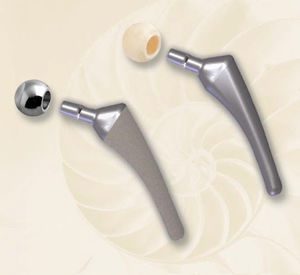
- Secondary care
- Orthopedic surgery
- Cementless femoral stem
- Biotech Medical

- Products
- Catalogs
- News & Trends
- Exhibitions
Cementless femoral stem BA
Add to favorites
Compare this product
fo_shop_gate_exact_title
Characteristics
- Fixation type
- cementless
- Femoral stem length
6.25 mm, 20 mm
(0.25 in, 0.79 in)
Description
The concept of this femoral component relies on a dose prosthesis-bone contact in both medial and lateral zones. The stem geometry shows a proximal to distal 3 degree taper providing a greater femoral canal fill, improving rotational stability and transferring load in the proximal calcar region to restore near normal stress distribution. Proximal off-loading reduces stress-shielding and thereby minimizes the potential for loosening. Straight stemmed wedge-shaped prosthesis have been widely used throughout more than 20 years and have proven to be very effective in both cemented as well as uncemented cases.
Rotational Stability
A critical parameter for successful THR is rotational stability, to which the design of the BA stem contributes through its geometry in combination with being collar-less. A collar-less prosthesis tends to allow for self seating, thereby improving load transfer to the femur and maintaining stability.
Lasting Fixation
Uncemented I Cemented Stems Long term survival of uncemented components depends not only on implant material and geometry, but also on the coating used for a biological fixation. For this reason, BioTech ™ has chosen the well-proven process of applying a circumferential plasma-sprayed porous titanium coating. This type of “dosed-pore” coating has no inter-connective spaces, a pore size ranging between 75-350 micron, thickness of 500 micron and approximately 30% porosity.
Catalogs
BA Stem
2 Pages
BA Revision Hip System
2 Pages
Exhibitions
Meet this supplier at the following exhibition(s):

Related Searches
- Bone plate
- Compression plate
- Metallic compression plate
- Locking compression plate
- Distal compression plate
- Compression bone screw
- Metallic compression bone screw
- Interbody fusion cage
- Proximal compression plate
- Forearm compression plate
- Mid-shaft compression plate
- Lateral compression plate
- General purpose compression bone screw
- Tibia compression plate
- Radius compression plate
- PEEK interbody fusion cage
- Humeral compression plate
- Femoral stem
- External fixation system
- Anterior interbody fusion cage
*Prices are pre-tax. They exclude delivery charges and customs duties and do not include additional charges for installation or activation options. Prices are indicative only and may vary by country, with changes to the cost of raw materials and exchange rates.







